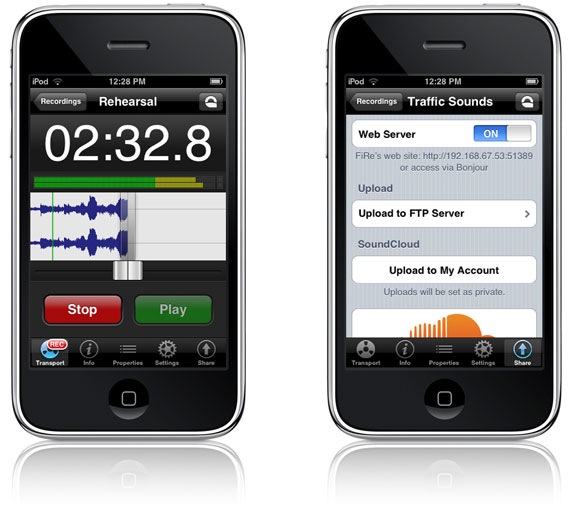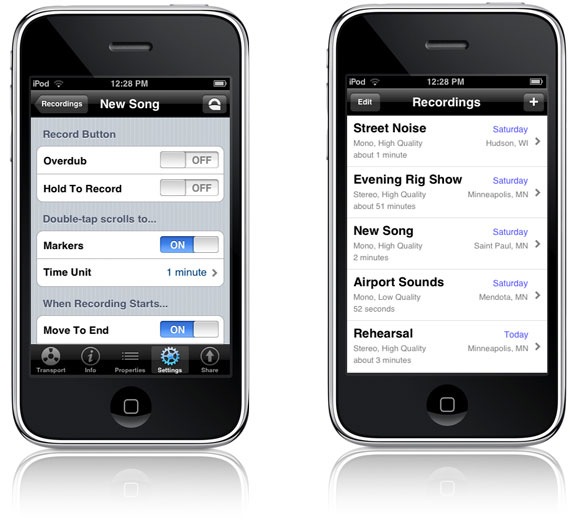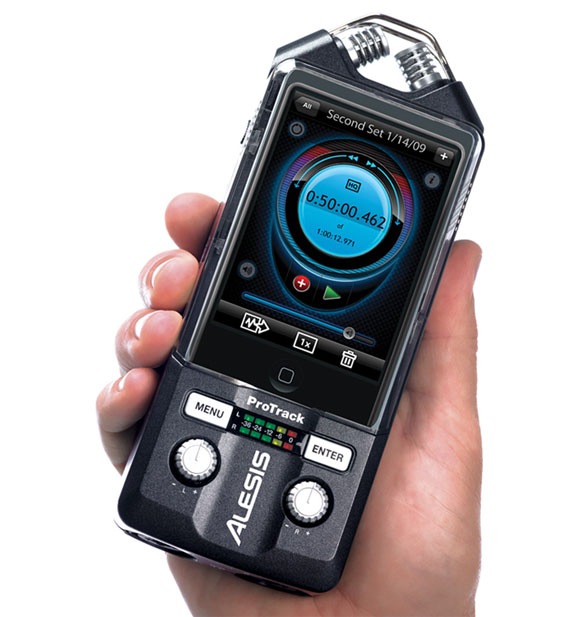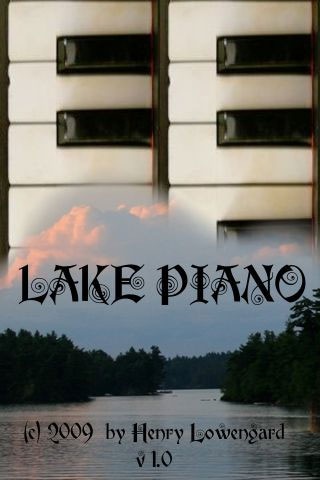Your pocket is bulging with power.
Wait… okay, that sounded really wrong.
Anyway, the mobile software revolution continues. There’s so much stuff out there that it can actually be hard to track. Here’s a round-up to help you navigate everything that’s going on this week.
And even if you can’t stand another word about the iPhone, consider this: the explosion of iPhone software, more than just a fad, illustrates what happens when you give developers tools to make multimedia capabilities easier, then provide a distribution outlet. I don’t love everything about the iTunes approach, but those are lessons that could easily be learned in desktop and mobile development alike. The iPhone platform, if nothing else, is surprisingly uncompromising in the sound and visual interaction departments, especially for a mobile platform. And even desktop platforms could benefit from this kind of distribution mechanism (see also: Steam for games).
Also, we do have some of the first signs that the iPhone won’t be alone for long – new functionality on Google’s Android could take that platform in new directions. See my next story, Android/Linux/open source fans.
Disclaimer: don’t worry. I’m not giving up on desktop apps. Relax. In fact, even now as I look across these applications, while there are lots of cool ideas, it’s still clear this is a nascent area. The experience is nowhere near as rich as you get on the desktop. But it’s nonetheless worth exploring some of the ideas before we return to our (more powerful) desktop applications for music.
Field Recording, Microphones for iPhone + iPod touch
The big news this week was FiRe, which promises to be the “first professional field recorder” for the iPhone and iPod touch. The developer behind it is one of which we’re already big fans: Audiofile Engineering. AE make Wave Editor, which has rapidly become the secret weapon of choice for Mac audio producers and sound designers, as well as the batch-processing Sample Manager and adoptive parents of the excellent Rax plug-in host. Anything these guys do would get our attention, and then they go and add specs you wouldn’t expect to see on the iPhone:
- Accurate real-time waveform display
- Live, touch-controlled waveform navigation
- Audio markers
- Broadcast WAVE metadata
- Instant downloading in multiple formats – and easy sharing via FTP, Web server, or even a SoundCloud account
- Tag recordings with location data
- Overdub mode
- VU meters for input and output
- Configurable time units
- Mic flexibility: use Blue Mikey, Alesis ProTrack or even the internal mic
US$5.99, available now.
(Update) Hardware Requirements:
iPhone 3G
iPod Touch (second generation)
First Generation iPhone (headset ONLY)
http://www.audiofile-engineering.com/
iTunes link (which is tricky to find otherwise)
Let’s just cut straight to it: this is, bar none, the most full-featured app out there. It’s the first one that would make me seriously consider using this platform for recording.
This, of course, raises the question of which mic you might want to use.
If you’re on the iPod touch, you don’t have even a built-in mono mic. (Don’t knock it: I’ve put together entire pieces based on simple mono mic samples. Creative sampling artists will use anything.)
Even on the first-generation iPod touch, you can use some simple solutions that will let you do basic sound.
The Smule blog has a terrific round-up of recommendations for touch owners wanting to use their Ocarina app. Their technical needs are much lighter than what you might need for FiRe, but this is still worth a look if you have any interest in recording at all:
Microphones for iPod Touch Ocarina
The Griffin SmartTalk wins out for 2G owners. I have Griffin’s TuneBuds mobile, which has worked well enough for applications like RjDj. (Note that Smule have managed to get their app working with the first-gen hardware; FiRe requires the newer generation.)
At the fancier end:
Blue Microphones’ Mikey is a slim-line stereo condenser capsule that plus into the iPod accessory port. It’s hinged so you can play with placement at least a little, and there’s basic gain control (3 settings). It runs about US$80 street, which means it doesn’t have to compete with standalone recorders. Update: Audiofile Engineering say they’ve seen some issues with FiRe and Blue Mikey, and can’t officially support the combination. Readers have had some issues themselves. If you’ve already got a Mikey, this might be worth a try, but otherwise, you can await updated information as Blue and Audiofile Engineering attempt to address the problem.
Specific update: The problem sounds as though it is the combination of the production Mikey with second-generation iPod touch units running the current OS. This is expected to be fixed with the next OS release. Stay tuned for more.
Tha Alesis ProTrack is even more impressive-looking, but at US$249 list, it does start to get into the realm of “you could just go buy a dedicated recorder.” The ProTrack extends the iPhone by adding a shell with an X/Y stereo mic pair – one that looks quite a lot like the Zoom H4 mics – and even has onboard XLR jacks and phantom power. You also get LED monitoring, a limiter, additional power (four AAA’s), a mic stand mount – basically, it turns your iPhone into a real mobile recorder.
The Alesis has its own app, but the Audiofile Engineering option is looking more powerful. Naturally, that’s the advantage of software – because the iPhone is essentially a comput
er, you can add whatever software you like.
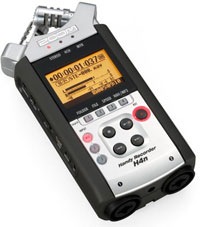 I still think there’s a good place for a dedicated recorder. I’ve started testing the Zoom H4n, seen at right. (Not an iPhone hiding in a shell.) I’m already blown away – it corrects most of the navigation and quality issues with its predecessor, and unlike an iPod or iPhone, has fantastic battery life and onboard XLR input jacks. (Okay, the ProTrack does have XLR’s, so this is getting a little more interesting.) In other words, I’m not sure I’m giving up on dedicated recorders in favor of one of these yet. It’s still handy to have, though – and who says you can’t use both, given how essential it can be to have a backup recording in many situations?
I still think there’s a good place for a dedicated recorder. I’ve started testing the Zoom H4n, seen at right. (Not an iPhone hiding in a shell.) I’m already blown away – it corrects most of the navigation and quality issues with its predecessor, and unlike an iPod or iPhone, has fantastic battery life and onboard XLR input jacks. (Okay, the ProTrack does have XLR’s, so this is getting a little more interesting.) In other words, I’m not sure I’m giving up on dedicated recorders in favor of one of these yet. It’s still handy to have, though – and who says you can’t use both, given how essential it can be to have a backup recording in many situations?
Updated: Officially, here are the mics supported by FiRe:
- Alesis ProTrack – http://www.alesis.com/protrack
(Requires iPhone 3G or 2nd gen. iPod Touch) - Blue Mikey – http://www.bluemic.com/products/mikey
(Requires iPhone 3G)
Thanks to Gaëtan Gravel and everyone else who sent this in.
Paul Van Dyk’s DJ Tools
This one was a bit of a surprise: Paul Van Dyk has released a DJ app, but it’s not just a quick, attention-grabbing, “DJ on your iPhone” gimmick. It’s more like a utility belt for DJs. I’m surprised to see that as a result it’s actually gotten some criticism. To me, finding some genuinely useful stuff you might want to have on your mobile device is the whole point.
What’s in there?
- BPM counter
- Frequency analyzer
- Noise level (the “NYPD Application”), with an oddly beautiful visualization
- Seismic reader (for testing your turntable, not for telling if there’s an earthquake happening – that you’ll probably figure for yourself)
And then some silly stuff, too – glow stick, anyone?
Not yet available – coming late May 2009
All interesting, but you know what this means: now we need Live PA Tools. (I can think of some ironic choices for that. Nominations welcome.)
Nine Inch Nails App
NIN, of course, had their app become available on 4/14. There’s been quite a lot written about it – so much, in fact, that I feel like the whole thing is a bit overhyped. The basic development here is that NIN is taking all their fan data and making it location specific. On the upside, this is a lot more than many high-profile bands have done with iPhone development. But then, these guys should be doing more – they have the budget to hire real developers. I do like the idea of fans being able to interact on their mobile device; that clearly makes a lot of sense. But few artists will inspire the kind of loyalty NIN does, which means the real question is, will someone be able to build a platform for everyone else? And if you are a more obscure artist, what should you be doing?
The app is free, so just a conduit for fans, really.
Gestural Beat Sharing, Celebrate Cinco De Mayo
ZoozBeat is the application I looked at in the fall: the idea is to make musical improvisation more accessible by allowing people to use fun gestures, taps, and the like to assemble beats. The software is not only for iPhone, but the powerful Nokia N95, too.
That story is worth checking out from the perspective of gestural music in general, not just iPhone or mobile apps:
Gestures, Mobile Music, and the “Low Floor” for Novices: ZooZBeat on iPhone, Nokia
The latest news: the guys have gotten funding, for one. More importantly to end users, ZOOZ Mobile is adding a sharing component, much like what we saw with Smule’s Leaf Trombone. New upgraded software adds a Latin component with Samba and Tejano rhythms and is ready-to-go for Cinco de Mayo. Sounds great to me – and the Latin market has been oddly ignored by a lot of musicians and developers. There are also new Pop, Hip-Hop, and Techno beats.
Unusual Instruments
You’ve got plenty of faux-808 apps for the iPhone now. Our friend Henry Lowengard is taking a very different tack, with drone-friendly creations and detuned pianos. He describes this as well as I could, so here’s what he writes to tell us about.
Imagine a piano in a summer home on a small lake, far in the north of the Northeastern United States. Imagine the piano sitting there for 60 or 70 years, untuned and unmaintained.
The naturally prepared timbres of the Lake Piano are now here for you, each missing felt, each individual nuance of the key action and character-filled tones. Briskly recorded one summer in lo-fi, these samples also contain sounds of children, cats, screen doors, and the summer breeze.
The first version of Lake Piano is relatively minimal, Henry says, played as a double row of scrolling piano keys and the ambient sounds stolen from a videotape he recorded. Henry promises more playability and more ambience in an upcoming upgrade, but you’ll get that automatically when it’s done, so you can always go play now.
And for droning on and on – literally:
Hi Droning fans:
I just sent in my new droning app Droneo to Apple for approval, so with luck, it’ll be in the store next week.
I’ll send a more widely distributed email when that happens, but I though you (pl.) might like to take a look at the Droneo "instruction site", http:
//www.jhhl.net/iPhone/Droneo/ and listen to this tantalizing demo:
http://www.jhhl.net/iPhone/Droneo/Audio%20Examples/Mp3/complex1.mp3
It’s basically my iPhone SrutiBox simplified to 8 oscillator voices, allowing a little more CPU time for complexity, and removing the preconceptions about Carnatic music and harmonium sounds that Sruti box engenders with its somewhat unpronounceable name.
For more on the SrutiBox, see our previous story.
Okay, I’m exhausted. Back to the desktop.
And of course, for the best source of up-to-the-minute mobile music creation news – well beyond just iPhone – be sure to read:
